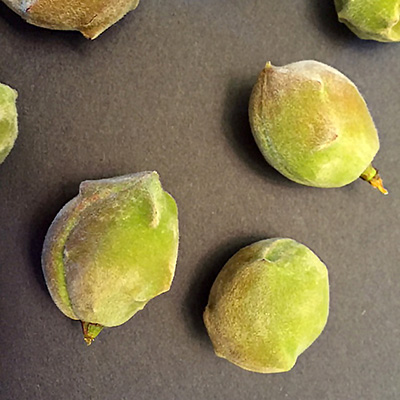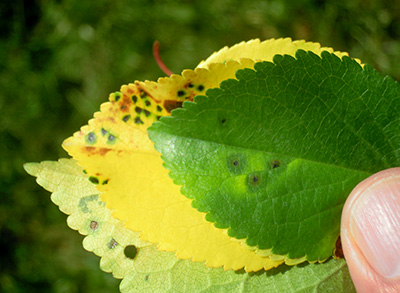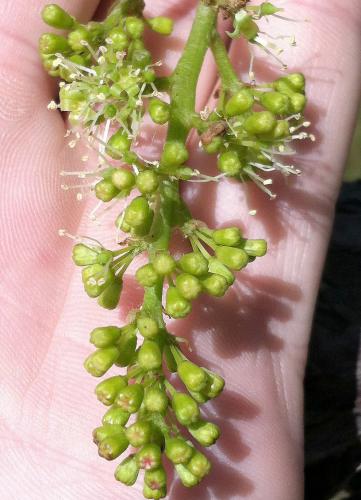Southwest Michigan fruit regional report – June 7, 2016
The hot weather in late May led to a large June drop in tree fruit. Strawberry harvest is underway. Grape bloom has begun.

Weather
Last week was a little cooler with high temperatures generally near 80 degrees Fahrenheit and overnight lows around 50 F. Saturday, June 4, was cloudy with a few scattered showers and storms moved through the region on Sunday night. Scattered rain fell in many areas with the passage of a cold front. Most areas received only a little rain, about 0.1 to 0.2 of an inch.
April and early May were quite wet and cool. Rainfall totals for April and May were similar with about 3.5 inches in both months, but most of May’s rain fell in early May. Relatively little rain has fallen in the last three weeks. Soils are drying out and some areas need irrigation.
Growing degree-day (GDD) accumulations really increased with the hot weather and high nighttime lows. Last week’s GDD totals were similar to the previous week’s totals. We picked up 32 GDD base 42, 27 GDD base 45 and 20 GDD base 50. We can expect GDD accumulations to be a little lower this week with cooler temperatures. High temperatures will be down to around 70 F in the mid-week then climb to the upper 80s by the weekend. Long term, we can expect warmer temperatures for the rest of the month.
Southwest Michigan GDD summary from Jan. 1-June 5, 2016 | |||
|---|---|---|---|
|
Station |
GDD 42 F |
GDD 45 F |
GDD 50 F |
|
Benton Harbor (SWMRC) |
1,154 |
946 |
659 |
|
Lawton (Lawton) |
1,195 |
981 |
687 |
|
Fennville (TNRC) |
970 |
782 |
526 |
|
Average for the region |
1,077 |
876 |
603 |
|
Accumulation last week |
224 |
162 |
138 |
Tree fruit
Sunday’s storms were an infection period for apple scab, cherry leaf spot and other diseases. Growers need to maintain insecticide protection on fruit as many insect pests are out and active. Insect activity last week was high with the warm temperatures. Trap catch numbers for moth pests were high with the warm weather last week. Leaf feeding pests are also active. Damaged shoot tips and feeding holes on the leaves from leafrollers are easy to find. Few new plum curculio stings were reported. San Jose scale crawlers are expected approximately June 13, based on the Trevor Nichols Research Station biofix of May 30.
Apricot fruit are over an inch in diameter, the pits are hard and the final swell of stage three growth should begin soon.
Peaches are over an inch in diameter and are large enough to start hand-thinning. The crop looks good. The predicted harvest dates for Redhaven in southwest Michigan range from July 29 to Aug. 2. Estimated harvest dates for some peach varieties are available on the Michigan State University Enviro-weather website in the fruit tools.
Oriental fruit moth numbers are down in many sites, indicating the end of first generation flight. Biofix, the first sustained flight of oriental fruit moth, was set as Monday, April 25, based on trap catches at the Trevor Nichols Research Station trap line. The Enviro-weather oriental fruit moth model indicated egg hatch began the week of May 22, 200 GDD 45 following the biofix. Flagging of terminal growth by oriental fruit moth larvae was detected last week.
Rains favor bacterial spot infection of young leaves and fruit, and bacterial spot symptoms are appearing on leaves of susceptible varieties. Peach varieties prone to rusty spot should be protected until pit hardening. It is too late to treat peach leaf curl; infected leaves will fall off. Peach fruit with wart-like symptoms of unknown causes are being reported. Similar symptoms have been seen occasionally in previous seasons.

Misshapen peaches with bumps or “warts” are being reported again this year. We have not yet determined a cause. Photo: Bill Shane, MSU Extension.
Sweet cherries are 14-16 millimeters in diameter. Early ripening varieties are beginning to color. Sweet cherries are susceptible to brown rot at all times, but especially so as they ripen. Protect sweet cherry fruit during warm, wet periods. Cherry leaf spot infects cherry leaves through the stomates and, once unrolled, the leaves are always susceptible to infection.
Tart cherries are generally 12 millimeters in diameter and the pits are hard. The tart cherry crop is spotty with differences between locations and within the orchard. Leaves continue to be vulnerable to leaf spot. Growers continue applying protectant fungicides for cherry leaf spot. Leaf yellowing has been observed in several orchards, but this was generally leaf symptoms of bacterial canker with large holes or black spots on the leaves. Some fruit symptoms were seen as well. European brown rot (Monilinia laxa) symptoms have also been seen in some orchards.

Bacterial canker symptoms on Montmorency tart cherry leaves. Photo: Mark Longstroth, MSU Extension.
Japanese plums are 18 millimeters in diameter. Bacterial spot symptoms can be found on more susceptible varieties.
European plums are 20 millimeters in diameter. Plums need to be protected against black knot from first bloom until second cover. Older black knot growth are actively growing now.
Apple fruit sizes vary from 18 to 25 millimeters in diameter. Fire blight shoot blight symptoms are appearing around blossom blight infections. Apple scab ascospores numbers continue to decline from the peak releases in late April. The Enviro-weather apple scab model indicated all apple scab spores have matured in most areas. There were only a few spores discharged during recent rains. Coverage to prevent primary scab generally continues into early June. Leaf and fruit primary scab lesions are easy to find on unsprayed trees and infected leaves are turning yellow and falling off the tree. MSU Extension advises to scout orchards for scab lesions to determine if scab program should be continued.
Codling moths were caught at the Trevor Nichols Research Station starting May 23. This is our regional biofix date. Trap catch numbers were high last week. Growers should use insecticides aimed at larvae. Leafroller larvae are feeding on the shoot tips and leaves in blocks that did not receive prebloom insecticide sprays.
Pears are 15 to 18 millimeters in diameter. Removing succulent water sprouts from the inside of the tree will help reduce sites for pear psylla population growth. Pear scab symptoms can be found on the leaves and fruit of unsprayed trees.
Small fruit
The first spotted wing Drosophila (SWD) of the season were trapped last week in Berrien County. This was probably the overwintering generation. These flies will be looking for ripe berries to begin egglaying.
Grape bloom has begun in juice grapes and some hybrid wine grapes. Vinifera grapes are not yet blooming. Bloom is the most important time to control black rot, powdery mildew, downy mildew and phomopsis. Many growers applied protectant fungicides and insecticides for rose chafer late last week before the flowers began to open. Grape berry moth flight is heavy. Dates for full bloom in wild grape, used in the Enviro-weather grape berry moth model, are May 28 for Berrien County and May 30 for Van Buren County. Growers should monitor the Enviro-weather grape berry moth model for the treatment date for second generation grape berry moth.

Bloom has begun in juice grapes. The petals in grape flowers open at the bottom and the cap falls off, revealing a naked flower. Grapes are generally pollinated by the wind and not by bees or other insects. Photo: Brad Baughman, MSU Extension.
Blueberry fruit are developing fast and the fruit set looks very heavy. Rains after bloom have really sized the early fruit. The largest fruit are about 8 millimeters in diameter. In the green fruit stage, growers need to treat for anthracnose and phomopsis as well as fruitworms. Cherry fruitworm trap catch continued and cranberry fruitworm trap catch really surged last week, indicating a strong flight. Materials to control these pests should already be on.
Some growers are applying sprays targeting blueberry stem gall wasps, even though this pest is rare in Van Buren County blueberry fields. Some growers have begun irrigating. Growers should pay close attention to soil moisture. Water is especially important after bloom when the berries are growing rapidly. Slight water deficits that reduce early fruit growth cannot be made up later.
Strawberry harvest is off to a strong start. Local strawberries will be available across southern Michigan into next week. Some strawberry fields or specific varieties have poorer than normal leaf growth. Be sure to maintain good irrigation now to maximize leaf function and fruit growth. Irrigation immediately after a picking will benefit when hot weather arrives over the weekend. The recent heat moved fruit quickly and the size of later developing fruit has suffered. Cooler weather this week will help size fruit for next week. Some fruit rots and insect damage has been reported. Growers with extended harvests should consider treating for SWD.
Bramble bloom is ending. Black raspberries (black caps) have green fruit as do blackberries and summer bearing red raspberries. There is no need to spray for SWD until the fruit begins to ripen.
Cranberry flower buds should open later this week or next. A prebloom fungicide spray is useful in reducing fruit rots and other diseases.
Upcoming meetings
Our next Monday fruit IPM meeting in southwest Michigan is June 13 at Fruit Acres Farms, located at 2559 Friday Road on the northeast corner of Friday and Carmody Roads, south of Coloma, Michigan, at 5 p.m. Two Michigan pesticide applicator recertification credits are available at these meetings.
Got pesticides? The first of two Clean Sweep Pesticide Collections is coming up June 29 in Benton Harbor, Michigan. The registration deadline is June 15. Get a registration form at Berrien County Clean Sweep Program or call 269-983-7111 ext. 8234.
See also:
- Management of bacterial spot on peaches and nectarines
- Controlling cherry leaf spot in orchards with early infections
- Effectively controlling plum curculio in stone and pome fruits
- Controlling black knot in Michigan
- Update on resistance to strobilurin fungicides in the apple scab fungus in Michigan
- Many materials available for pear psylla management
- Fruitworm control in blueberries
- Use anthracnose fruit rot prediction model to assess risk of infection.
- Managing blueberry stem gall wasp



 Print
Print Email
Email



